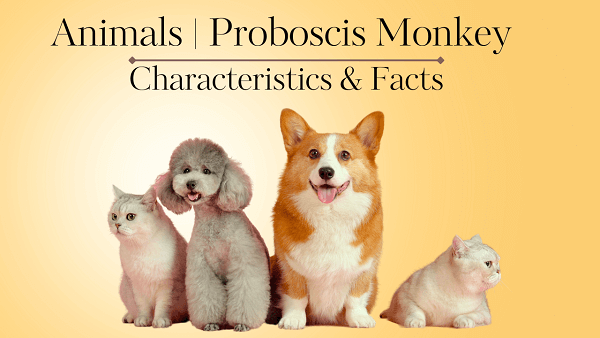
Proboscis monkey Definition | Characteristics & Facts
Proboscis Monkey Definition
The proboscis monkey, also known as the long-nosed monkey or Nasalis larvatus, is a unique primate species found on the island of Borneo in Southeast Asia. It is known for its distinctive large, fleshy nose, which gives it its name. Here's a definition of the proboscis monke
Proboscis monkey General Characteristics & Facts
Appearance
Proboscis monkeys are easily recognizable by their distinctive physical features. They have large, pendulous noses that hang down over their mouths, which is where their common name "Proboscis" comes from. Adult males have much larger noses than females, and the size of the nose is considered a sign of dominance. They also have a potbelly, long limbs, and a tail that is shorter than their body length.
Size
Adult male Proboscis monkeys are larger than females. Males typically weigh between 16 to 23 kilograms (35 to 50 pounds) and measure around 66 to 76 centimeters (26 to 30 inches) in body length, excluding the tail. Females are smaller, weighing about 11 to 14 kilograms (24 to 31 pounds) and measuring around 53 to 62 centimeters (21 to 24 inches) in body length.
Social structure
Proboscis monkeys live in social groups known as harems, which consist of one dominant adult male, several adult females, and their offspring. The male is responsible for protecting the group and will aggressively defend his harem against other males. Young males, once they reach maturity, are eventually forced to leave their natal group and join a bachelor group until they can establish their own harem.
Habitat
Proboscis monkeys are primarily found in coastal and swampy mangrove forests, freshwater swamps, and riverside forests of Borneo. They are well adapted to their habitat and are excellent swimmers, with webbed feet that enable them to move easily through the water.
Diet
The Proboscis monkey is primarily herbivorous, with its diet consisting mainly of leaves, shoots, unripe fruits, and seeds. However, they also consume some insects and occasionally small invertebrates. They have a specialized digestive system that allows them to efficiently digest leaves and break down toxins found in their food.
Conservation status
The Proboscis monkey is currently listed as an endangered species by the International Union for Conservation of Nature (IUCN). Their population has significantly declined due to habitat loss caused by deforestation, primarily driven by palm oil plantations, logging, and human development.
Conservation efforts
Various conservation organizations and government agencies are working to protect the Proboscis monkey and its habitat. Efforts include establishing protected areas, implementing conservation initiatives, promoting sustainable land-use practices, and raising awareness about the importance of preserving this unique species.
Unique vocalizations
Proboscis monkeys are known for their distinctive vocalizations. Males have a large, resonant throat sac that they use to produce loud honking calls, which can be heard over long distances. These calls serve as communication signals and are used to establish dominance, attract females, and warn of potential threats.
Importance to the ecosystem
Proboscis monkeys play a crucial role in the ecosystem as seed dispersers. By consuming fruits and seeds, they help in the regeneration of forests by dispersing seeds in their feces. Their feeding habits contribute to the biodiversity and overall health of the forest ecosystem.
Cultural significance
Proboscis monkeys hold cultural significance in the regions where they are found. They are often considered a symbol of Borneo's wildlife and are a popular tourist attraction. Their unique appearance and behaviors make them fascinating subjects for researchers, photographers, and nature enthusiasts.
Physical Characteristics of Proboscis Monkey
- Prominent Nose: The most prominent feature of the proboscis monkey is its long, fleshy nose, which is much larger in males than in females. The male's nose can grow up to 7 inches (17.8 centimeters) long, hanging down over their mouth. In contrast, the female's nose is smaller and shorter.
- Bulging Belly: Proboscis monkeys have a potbelly or distended abdomen, especially in adult males. This is due to their large, multi-chambered stomach, which helps digest their herbivorous diet of leaves and unripe fruits.
- Size and Sexual Dimorphism: Male proboscis monkeys are significantly larger than females. Adult males can reach a length of around 2.5 feet (75 centimeters) and weigh between 44 and 66 pounds (20-30 kilograms). Females are smaller, measuring about 22 inches (55 centimeters) and weighing between 22 and 33 pounds (10-15 kilograms).
- Coat Color: The proboscis monkey has a reddish-brown to dark brown coat, with a lighter-colored belly. The fur on their back can appear shaggy and rough. Newborn proboscis monkeys have a lighter coat that darkens as they mature.
- Webbed Feet: Proboscis monkeys have partially webbed hands and feet. This adaptation allows them to swim and move efficiently through the water as they inhabit coastal mangrove forests and often come in contact with rivers and swamps.
- Long Limbs and Tail: Proboscis monkeys have long limbs and a long, muscular tail. Their limbs aid in climbing and moving through trees, while their tail is prehensile, meaning it can grasp and hold objects, helping with balance and locomotion.
- Facial Coloration: Adult male proboscis monkeys have distinctive facial coloration. Their faces can vary from pale to bright red or blue, depending on their emotional and social status. The coloration is attributed to the increased blood flow to the face during times of excitement or arousal.
Continue To Explore All Animals That Start With M
Scientific Classification of Proboscis Monkey
Kingdom: Animalia (Animals)
Phylum: Chordata (Chordates)
Class: Mammalia (Mammals)
Order: Primates (Primates)
Family: Cercopithecidae (Old World Monkeys)
Genus: Nasalis
Species: Nasalis larvatus
Key Locations of Proboscis Monkey
- Malaysia
- Indonesia
- Brunei
View All A-Z Animals List
Proboscis Monkey FAQs
What does a Proboscis monkey eat?
- Leaves
- Unripe Fruits
- Seeds
- Flowers
- Bark

